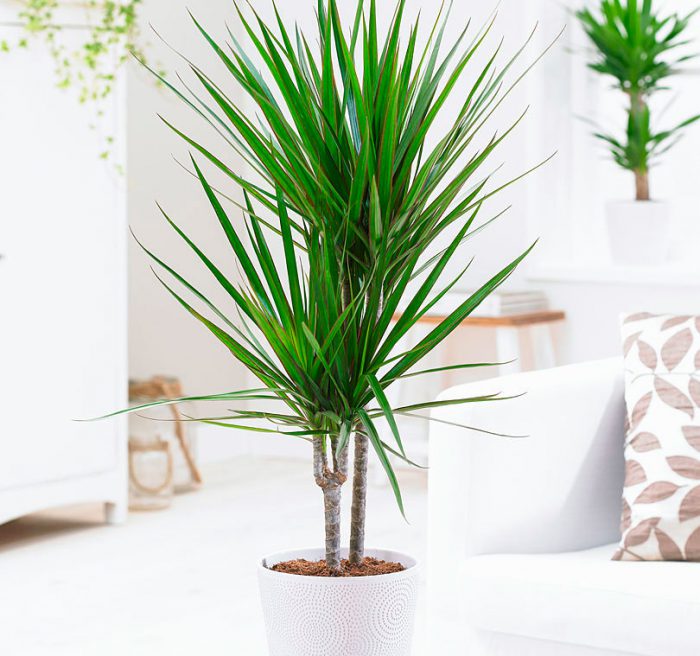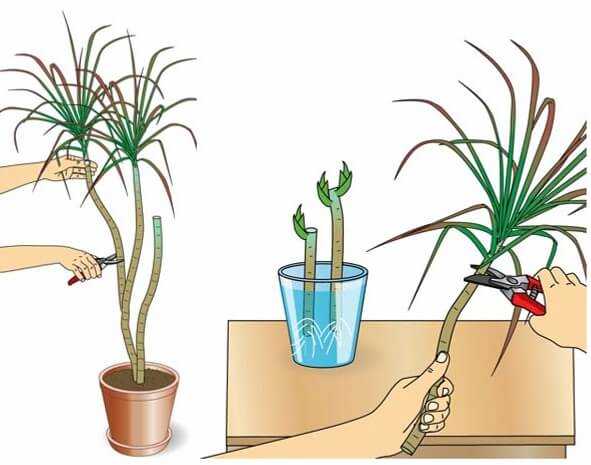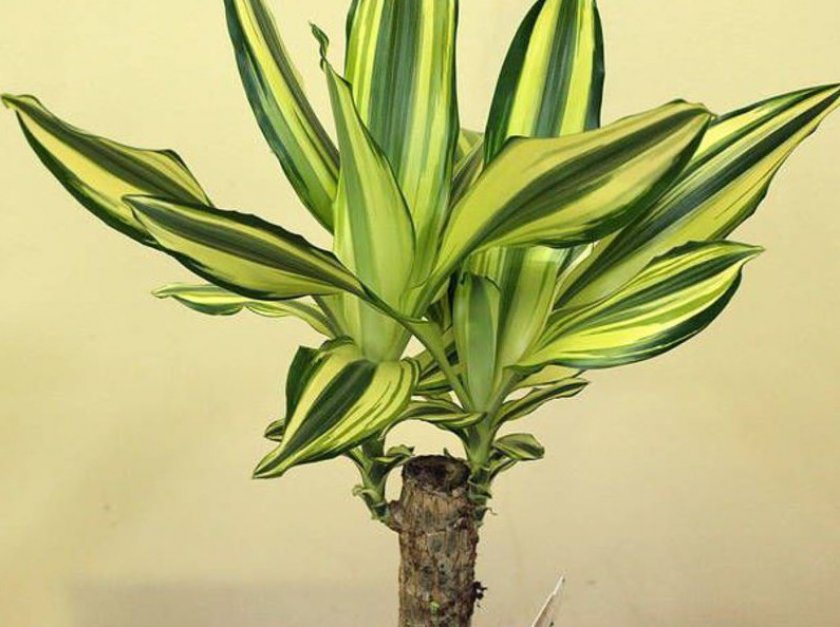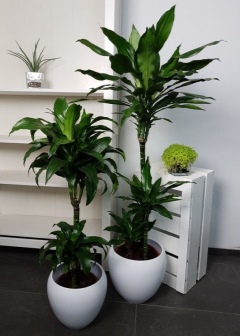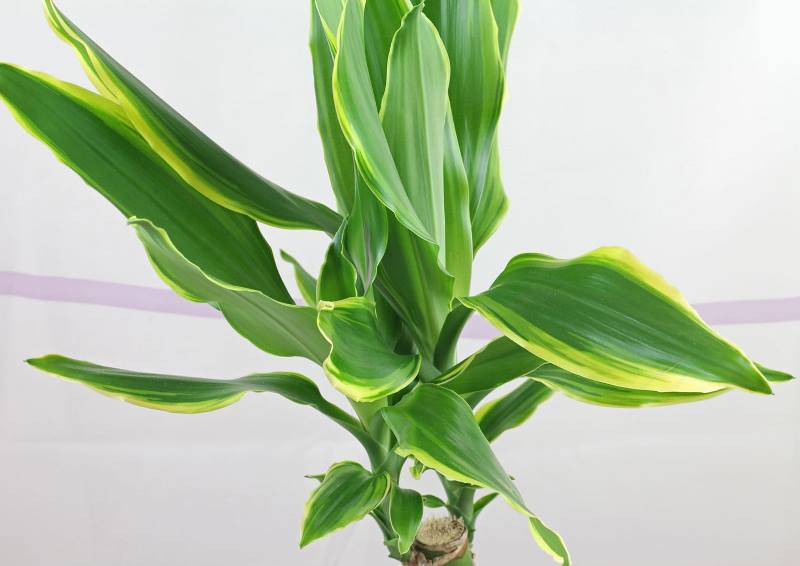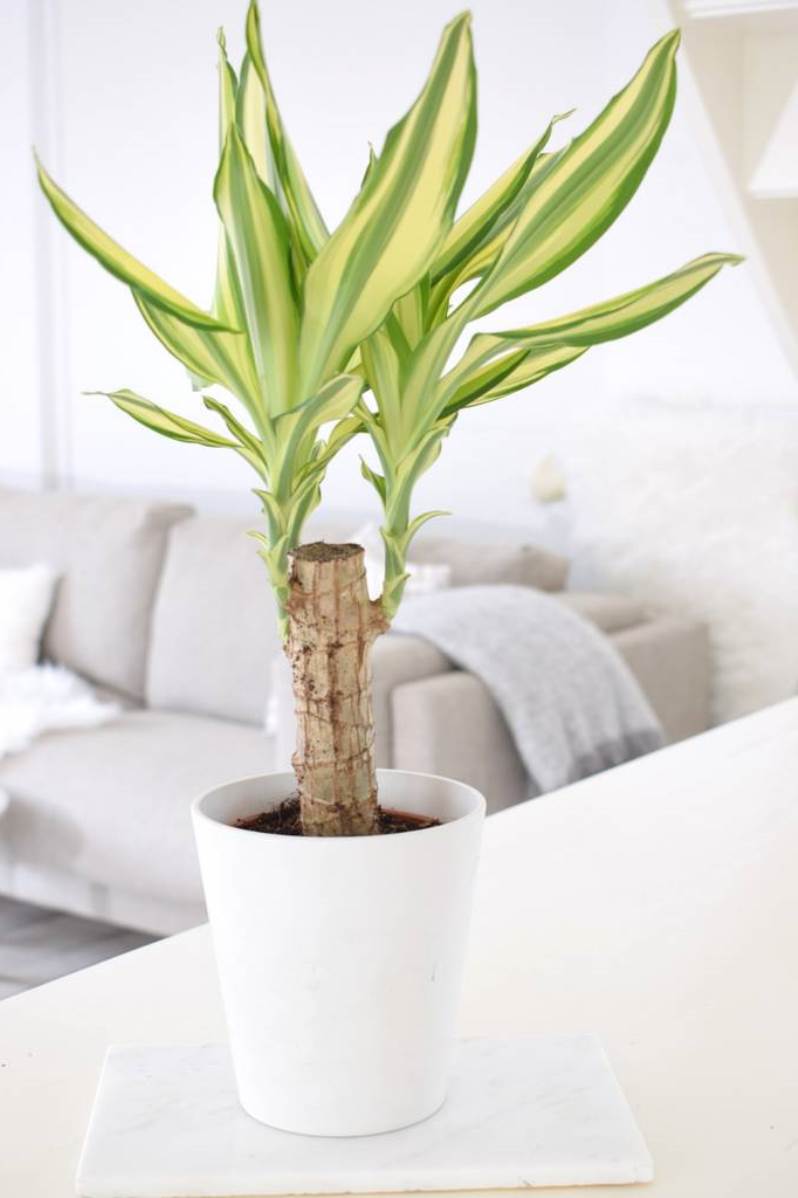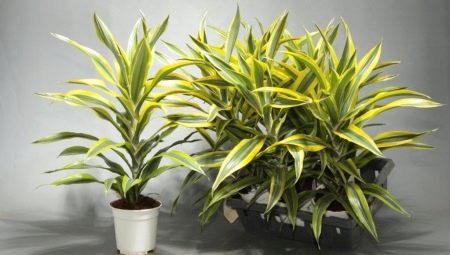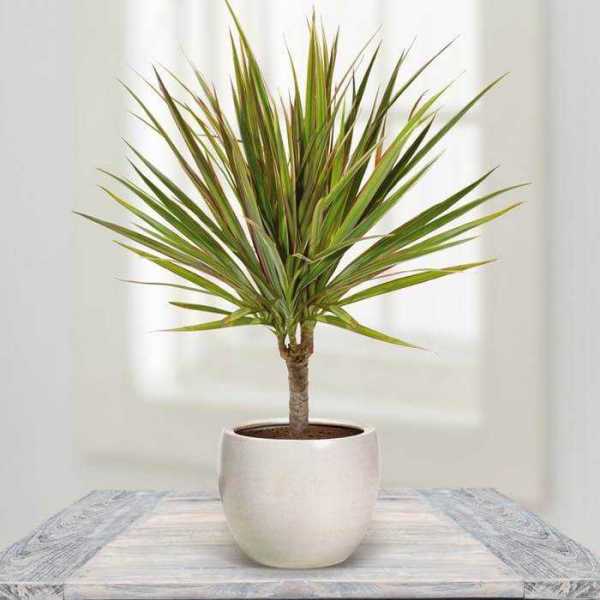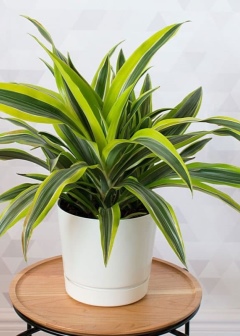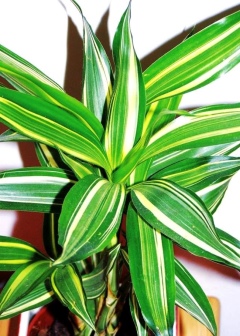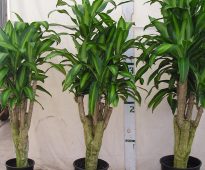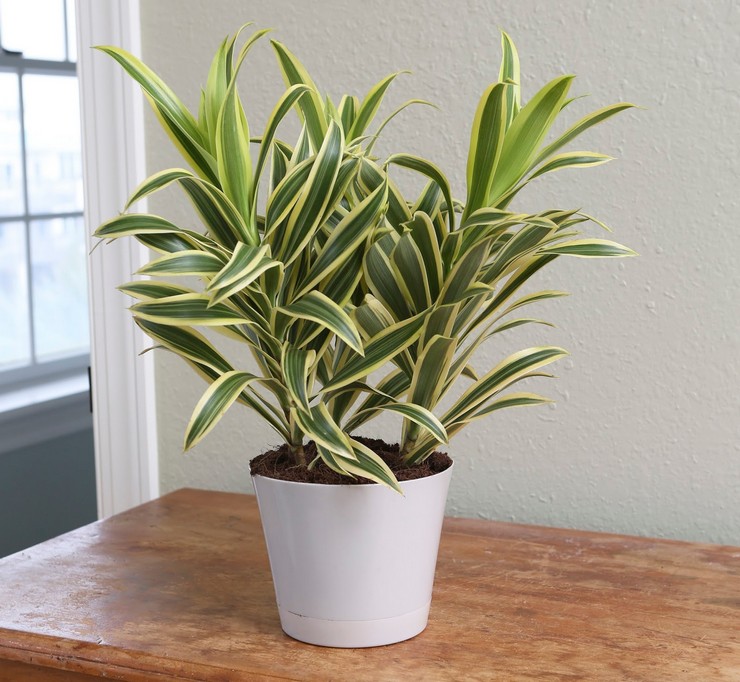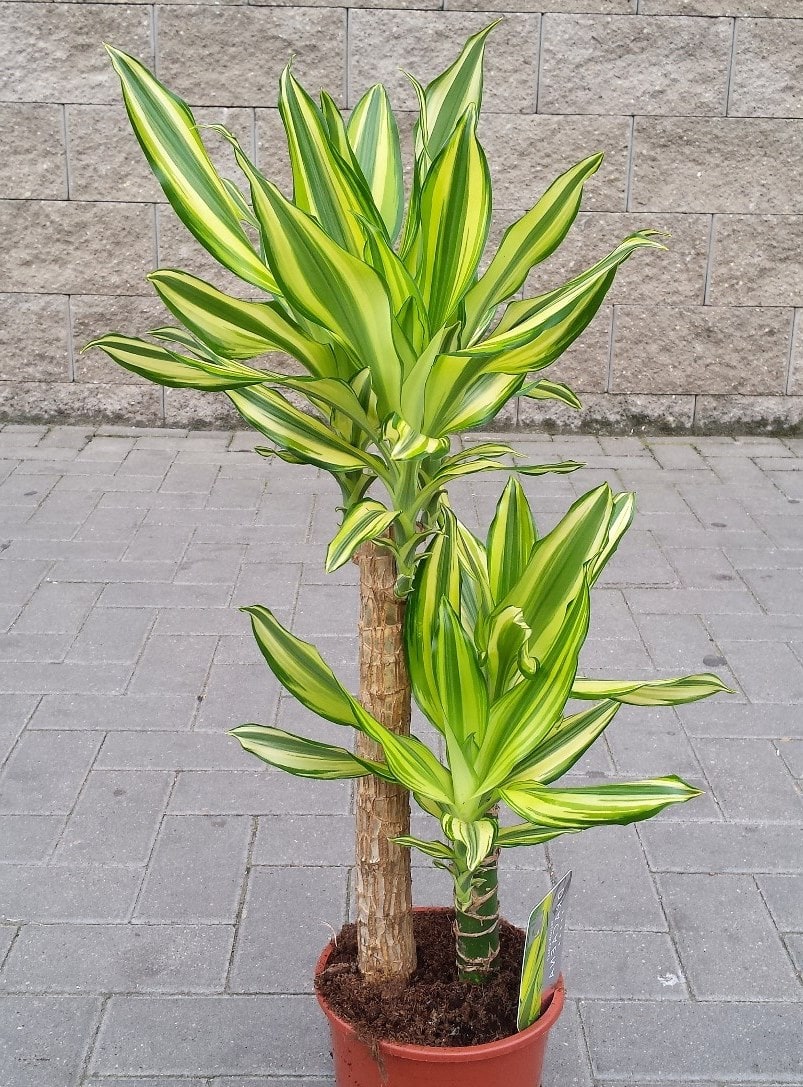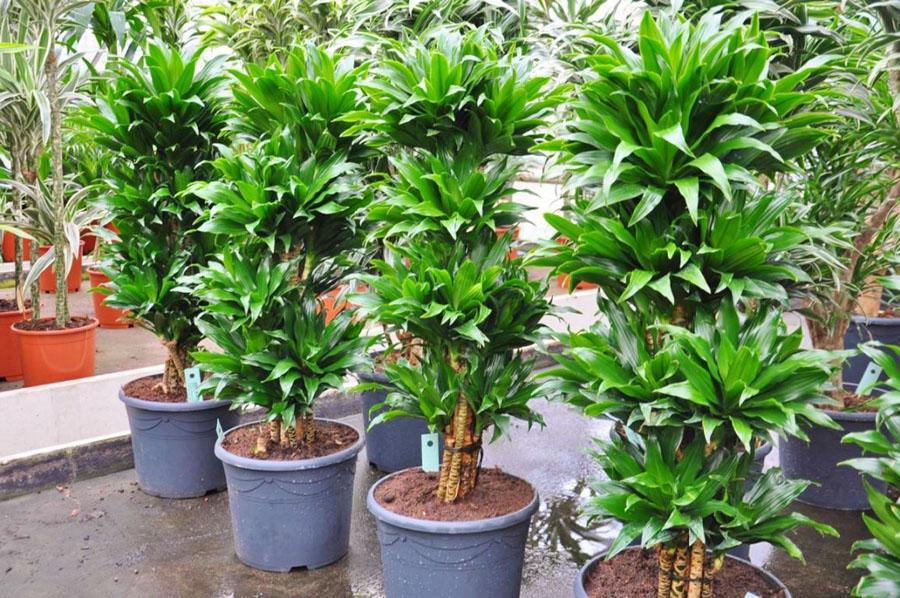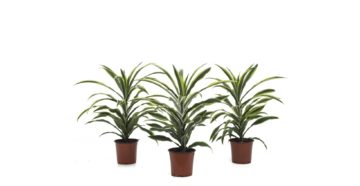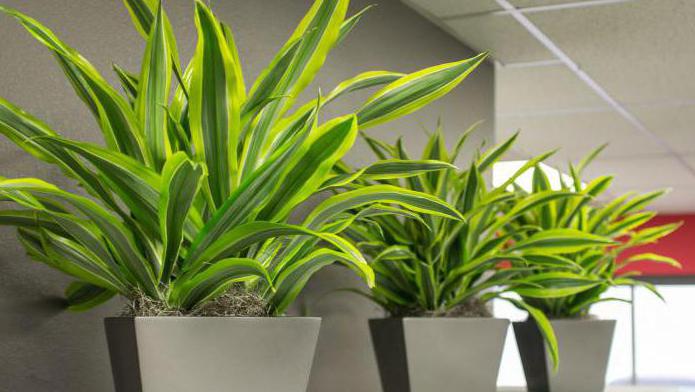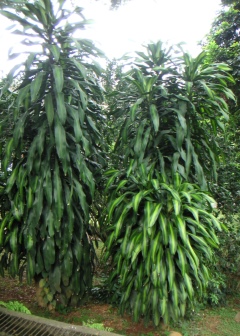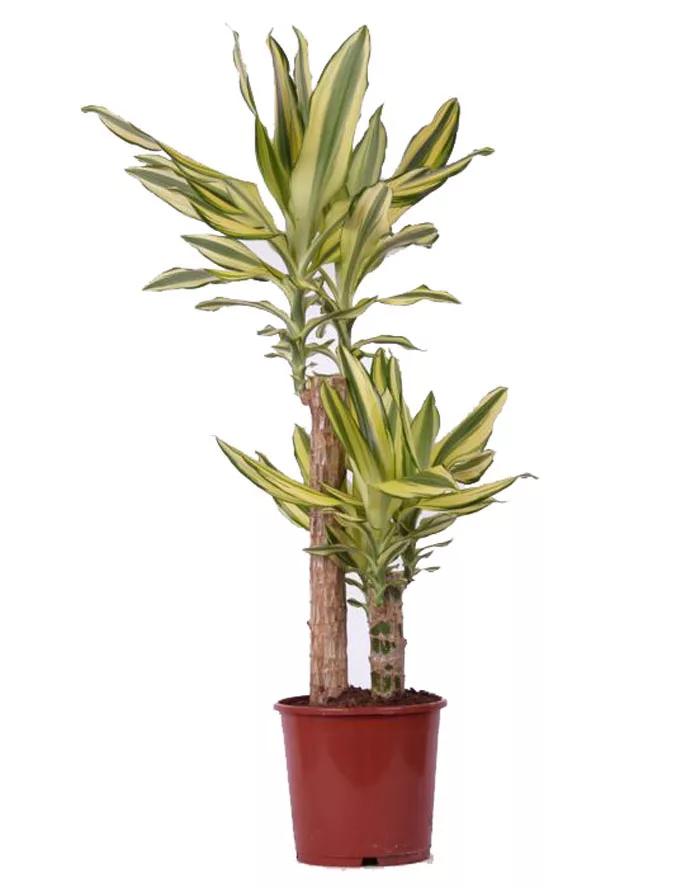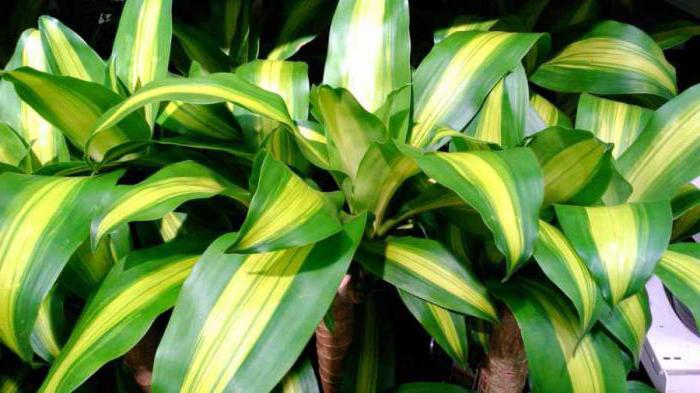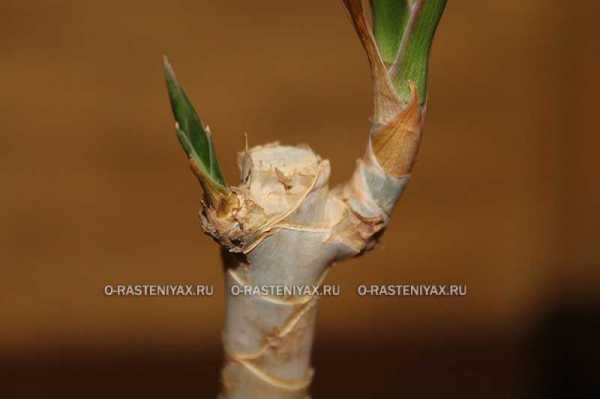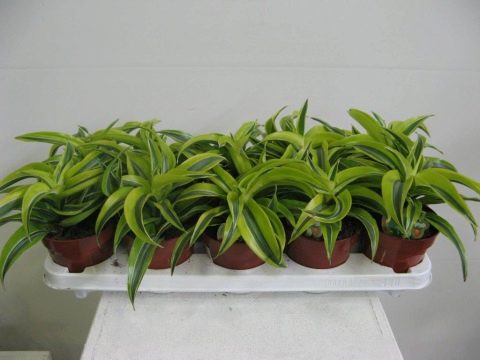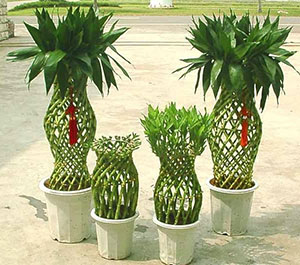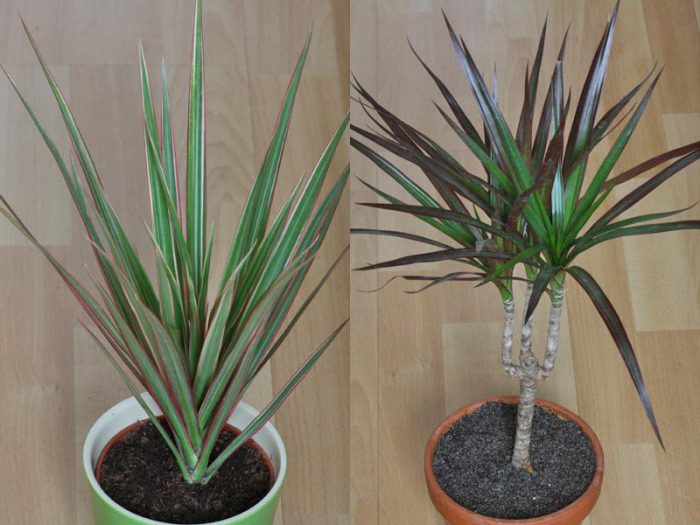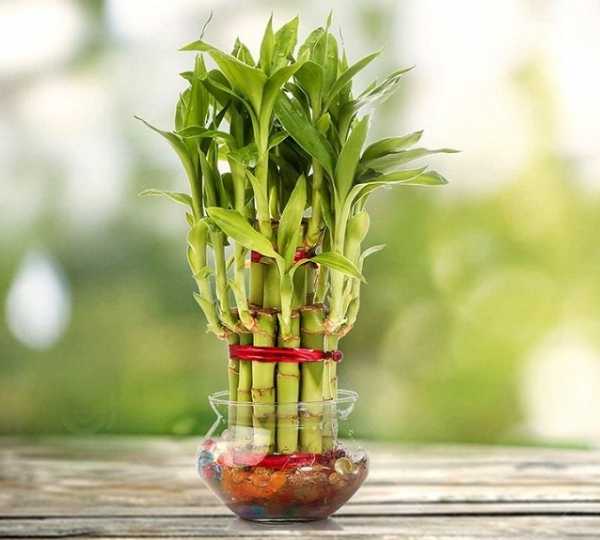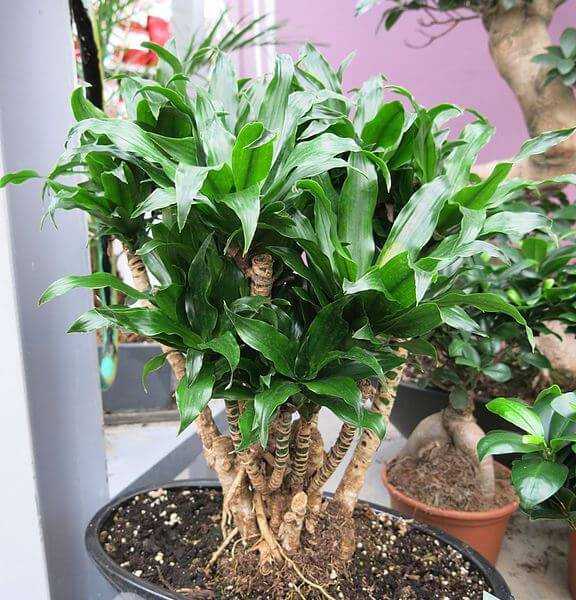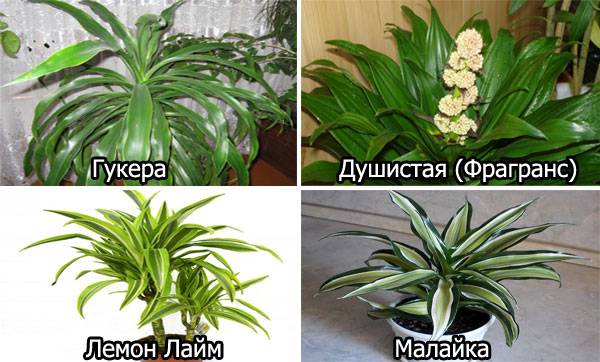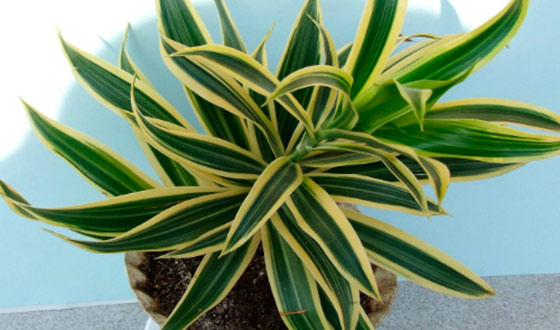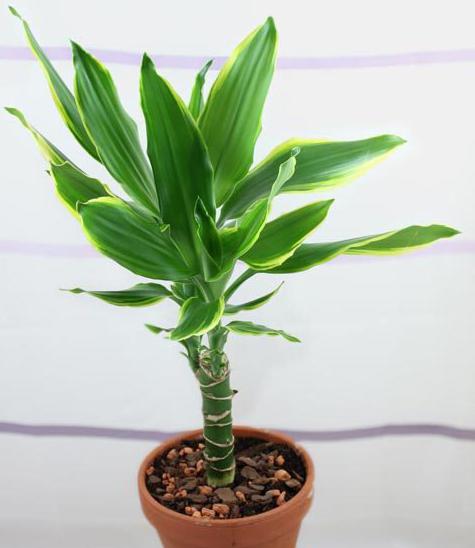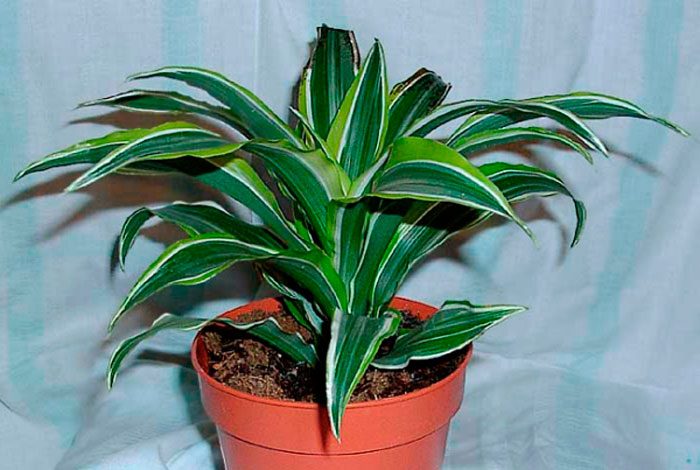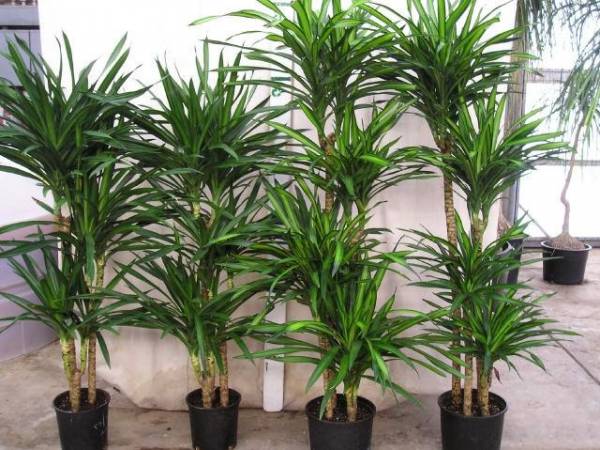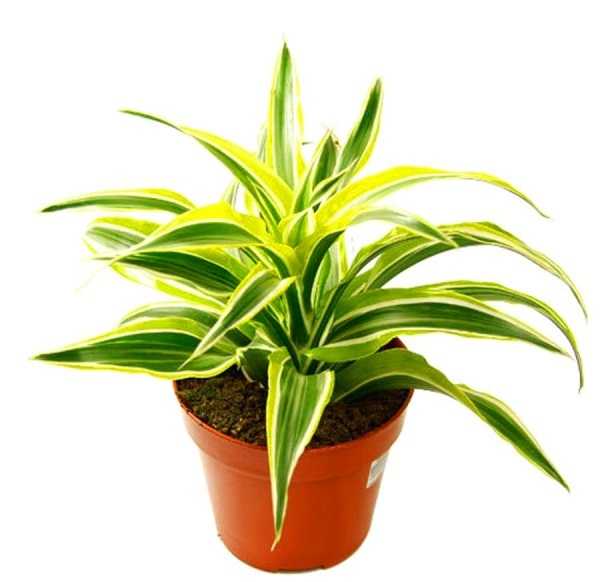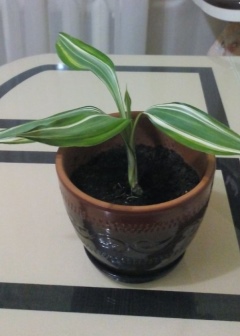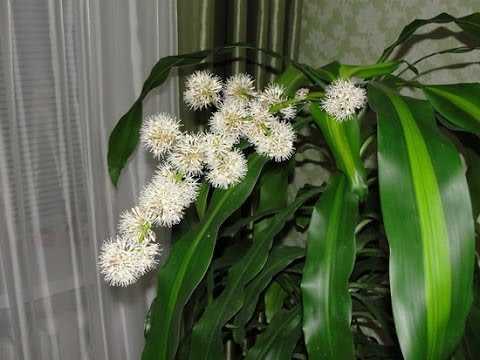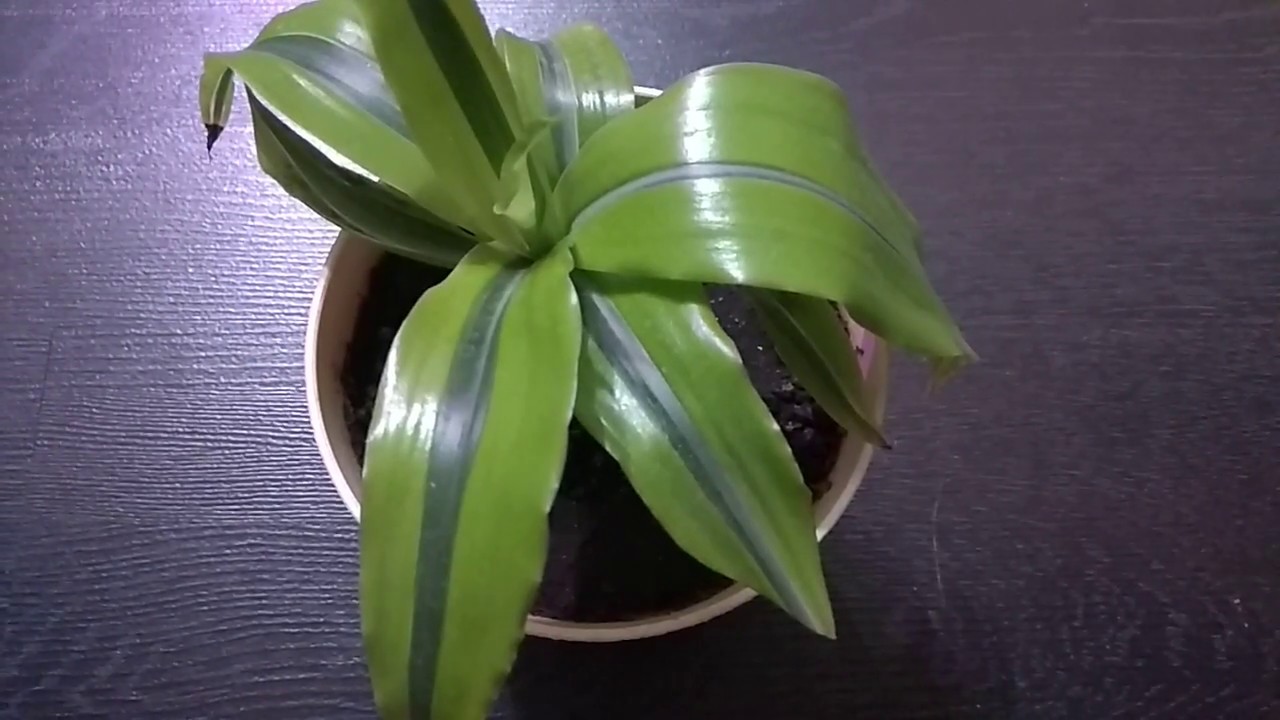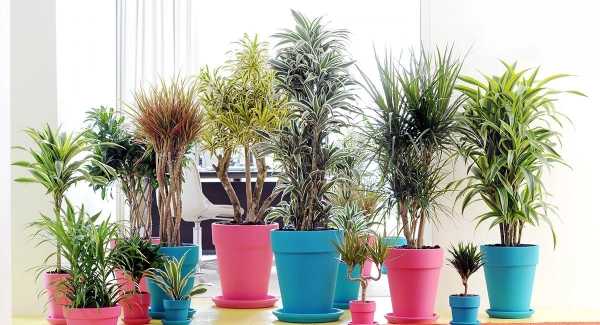Variety of species
Plants growing in the wild have been adapted for keeping at home. In addition to them, breeders have bred many hybrid varieties that differ in a variety of leaf colors and decorative qualities.
The most popular among indoor plant lovers are the following types of dracaena fragrant:
- Massangeana. This is a tall plant that looks like a palm tree. In the center of the sheet plate and on the sides there are yellow stripes.
- Compact. It is a dwarf plant with bright green leaves. This type of plant does not need bright sunlight and grows well in the shade, so it can be placed in the back of the room.
- Victoria. Dracaena leaves of this species are decorated with wide golden stripes.
- Lindeny. Leaves of this type have white stripes.
- Dracaena Lemon Lime. The variety is distinguished by its bright green leaves and a dark green stripe in the center of the leaf. Cream-colored stripes are located along the edge of the leaf plate.
Dracaena care at home
Lighting
For these house flowers, which look like a palm tree, it is quite acceptable to be placed in partial shade, but it is recommended to place them in brightly lit areas of the room, but without direct sunlight.
Varieties with variegated colored foliage require more light than plants with green leaves. Lack of lighting negatively affects the growth of dracaena.
The most correct for growing are the east or west sides, which face the windows.
Air temperature and humidity
Although dracaena comes from warm regions, this plant does not like heat, dry air. The plant will fully develop in summer at a temperature of 20-25 ° С, and in winter - at 15-18 ° С. It is also necessary to maintain the humidity of the air by placing a container of water next to it or spraying the dracaena once a week.
Did you know? The plant benefits in various industries: brushes, juice are made from dracaena and horsehair fibers, and resin is used for treatment. The plant itself has a positive effect on the nervous system, bringing peace and good mood.
How to properly water dracaena
In order for the plant to please with its healthy appearance and lush greenery, it must be properly watered. Watering frequency depends on the variety, but there are general guidelines.
Watering rules in summer
Dracaena grows mainly in summer, so you need to water it in large quantities during this period. However, there is the following nuance - watering should be done after the topsoil dries up by 2-3 cm. This usually happens on the 8-10th day after the previous watering.
How to water dracaena in winter
Already in the fall, the soil dries up much more slowly, the dracaena rests during this period and until the end of the winter cold. Accordingly, watering is needed less frequently. Its frequency is once a month. You need to focus on the drying out of the soil, because the plant can stand near the heater, which means that watering will be needed more often.
It should be remembered that your home palm flower does not tolerate frequent watering, since they lead to stagnant water and root rot, so do not make such a mistake in leaving.
Top dressing and soil care
There are special complex dressings that are designed specifically for indoor plants and are sold in stores. It is preferable for the plant to fertilize in liquid form. They should be applied with water for irrigation.At the same time, it is necessary to take into account that it is better to do this during the period of active growth, that is, in the spring-summer time.
Many lovers of indoor palms, and indeed flowers in general, are interested in their growth, so they want to provide them with suitable care.
An important question is how to fertilize dracaena for rapid growth.
This plant needs the following elements: nitrogen, phosphorus, potassium in a ratio of 3: 1: 3. Therefore, select the right fertilizer based on the presence of these substances in its composition.
Important! In summer, dracaena is fertilized once a week, and in winter, when the plant is resting, it is better not to do this more often than once a month.
The soil is very important for dracaena: nutritious and slightly acidic is preferred. You can buy ready-made soil in the store, there are special mixtures for this type of deciduous plants. If you decide to prepare the soil yourself, then you need to take an equal number of parts: deciduous soil, sand, humus, turf and peat.
Dracaena pruning rules
Dracaena pruning can be done in cases of preventing the spread of the disease or in order to change the shape of the plant.
Dracaena should be trimmed during the rest period, that is, in winter. It is imperative to disinfect the pruning tools, and sprinkle the cut points with charcoal or wood ash. You can cut off the top of the main trunk, after which lateral shoots will begin to grow at the dracaena.
Care
Taking care of dracaena at home is not so difficult. It grows quickly, so timely pruning is required, unless you want to have a tall palm tree. The grower will need to monitor the tree for spider mites, which live and feed mainly on the underside of the foliage. To remove them, you do not need to use chemicals, you just need to put the flower in the bath and rinse the leaves under a high pressure of water, for example, using a shower.
Temperature and humidity
The described plant does not like the cold, because it is used to the tropical climate. His homeland is the Canary Islands. For this reason, in the room where the dracaena stands, the temperature should never drop below 10 ° C. If this condition is not observed, then the foliage will begin to rot, and the tree itself will die.
When the plant is transferred outside for the summer, it is worth remembering that at night the air temperature should not fall below the specified mark, because even a slight frost will kill the tree. The temperature range for ideal growth is between 16 ° C - 24 ° C.
The plant has special requirements for moisture, so the grower must strictly monitor this parameter. The soil must remain moist, but not wet, as this will rot the roots. Dracaena can withstand a short drought, but no waterlogging. Reduce watering in the winter, because during this period a lot of water is not required for growth.
Reasonable humidity in the room is needed, because sometimes it becomes noticeable how brown spots appear on the foliage, which are the reaction of the flower to non-compliance with the conditions of detention. Specifically for this plant, this figure is from 60 to 100%.
Lighting
Dracaena loves light and warmth, but does not like to be in direct sunlight, since in its natural environment it grows under the shade of taller tropical trees. An ideal location is where it is bright for most of the day, but the lighting is diffused. A window sill on the north side of the house is well suited. On the southern one, you can also put a pot, but position it so that the sun does not fall on the tree, otherwise spots will appear on the foliage.
Fertilizer
As for the soil used, then there is nothing special, the described plant only needs to dry it well and use a pot with drainage holes to prevent root rot. You can add stones to the bottom of the container to keep the water from stagnating.This and any other variety does not need a large amount of fertilizer, but if you want to promote growth, then it is allowed to apply top dressing once a month during the growing season (spring, summer).
Watering
It is necessary to water the plant when the soil has already dried out, while it is worth taking care of good drainage. For irrigation, warm water without fluoride is used, so you should not take it from the tap. If there is a well, it is advisable to use water from there or rainwater, which must be heated before watering. If there are no such options, then you need to use distilled.
Water is poured into the pot until it flows through the drainage holes from the bottom onto the tray. It is drained 30 minutes after watering, when all the excess has already flowed out. If rot and an unpleasant odor appear, this means that the breeder has too often moistened the soil and the plant has begun to rot. In this case, you can still help, for this you just need to wait until the soil dries out, and subsequently establish the correct mode of soil moistening.
Pruning and shaping the crown
An adult plant must be pruned in a timely manner, thereby forming an attractive crown. Cut off the main stem of the tree if the stem gets too tall. Pruning is done to the desired height using scissors. The top can then be planted in the ground and it will germinate, forming a new tree. A bare trunk will develop two or more side branches and new foliage under the cut.
Pruning and reproduction of fragrant dracaena
The older and higher the fragrant dracaena depicted in the photo becomes, the more it resembles a palm tree. Old leaves dry up and leave the trunk, which remains naked and devoid of lateral shoots.
An adult plant at home requires a support device, but this measure does not help when decorativeness is lost.
In this case, it is reasonable to resort to updating. In dracaena, the top of the shoot with 5 - 7 leaves is cut off. Cover the bare trunk with a bag and leave it warm. After about a month, the awakened buds begin to form additional lateral shoots. As a result, the plant is shortened, becomes lush and more interesting.
The remaining top of the dracaena should not be thrown away. This is an excellent apical cutting for rooting and propagation of fragrant dracaena.
Lower part of the top:
- freed from several leaves at the base of the cutting;
- placed in water with the addition of crushed charcoal or buried a couple of centimeters in a mixture of sand, sphagnum and peat.
Under the film or in a greenhouse, the dracaena will give roots in 3-4 weeks. So you can become the owner of a new specimen of decorative culture. The easiest way to propagate fragrant dracaena is in the spring or in the second half of summer.
Dracaena disease
If leaves turn yellow and fall?
The most common problem of Dracena Marginat is drying of the tips of the leaves or complete drying of the sheet, followed by falling off. This occurs, as a rule, under the influence of dry air. If dry leaves have already appeared, it is permissible to cut off the tips, but only slightly. Cutting the leaf too tightly can cause further drying.
Yellowing of leaves is usually associated with over-watering
To avoid health problems of Dracaena Marginata, which is quite unpretentious to care, you can follow the rules of watering and spraying, as well as providing the plant with comfortable lighting, temperature and humidity. Another reason for the drying out of the leaves is the lack of replanting for several years.
But it is important to remember that leaves can fall off for natural reasons. Dracaena leaves have a lifespan of 2 years
After this period, the leaves dry out.
How to care for dracaena at home
Temperature regime
Dracaena prefers moderate air temperatures. In summer, the temperature should be maintained at 18-25 ° C. In winter, it should not fall below 15 ° C. In the warm season, the plant should be taken out into fresh air.However, it is necessary to ensure that it does not stand in a draft, therefore, it is not placed near open windows. In hot weather, dracaena is sprayed, provide additional watering.
Lighting
When choosing lighting for dracaena, its appearance is taken into account. Most of them prefer well-lit places. At the same time, direct sunlight should not fall on the plant. The ideal place for her would be western or oriental plants. Dracaena, which have dark leaves, do not require a lot of light. Variegated species with a lack of light will lose their color. Artificial lighting is also suitable for dracaens.
If it is necessary for the dracaena to grow, it is placed where there is a lot of light. In partial shade, the plant develops more slowly.
Air humidity
Most species of dracaena do not tolerate dry air, so they need to be constantly sprayed, regardless of the season. Spraying is carried out twice a day. Otherwise, the leaves will turn yellow and fall off.
It is equally important to regularly wipe the dracaena leaves from dust with a damp cloth. In some cases, it may not hurt to wash the plant in the shower.
This is especially true of dracaena deremskaya.
Dracaena Godsef and Dragon are the most unpretentious species. They do not need special conditions of detention. They also feel comfortable in dry air.
How to water a plant
Dracaena is classified as a moisture-loving plant. She needs abundant watering. Do not allow overdrying of the top layer of the earth. When it has dried by 2-3 cm, watered dracaena. In order for it to develop well, the soil in the pot must remain moist. Over-watering can kill the plant. Due to stagnant water, the roots will rot. In summer, dracaena is watered every day. In winter, watering should be reduced. For better development, the plants loosen the soil every month.
Water for irrigation should be soft. Rain or settled water will do. If you water it with tap water, white spots will appear on the plant.
Top dressing
Fertilizers are applied during the period of intensive growth of dracaena. It falls in March-August. The plant is fed twice a month. In the rest of the months, it is enough to fertilize the dracaena once a month. Complex fertilizers are used as top dressing. Variegated forms require specialized fertilizers.
Watering and feeding rules
It is necessary to take care of the "tree of happiness" all year round, especially during periods when the air temperature in the room rises (hot summer and winter during the heating season). Since dracaena is extremely demanding on the degree of humidity in the air and soil, properly organized watering is very important:
- In the summer, you need to water the soil in a pot twice a week, 3 more times a week the bush is completely bathed in the shower or sprayed from a spray bottle. Make sure that no moisture stagnates in the pot, otherwise the root system can rot and lead to the death of the entire plant.
- In the fall, when the temperature drops, dracaena is watered once a week. Spraying can be skipped if the humidity is high, or it can be reduced to 2 times a week.
- In winter, be guided by the indoor microclimate. If the temperature in the room does not exceed + 18-22 ° C, it is enough to water the plant 2 times a week.
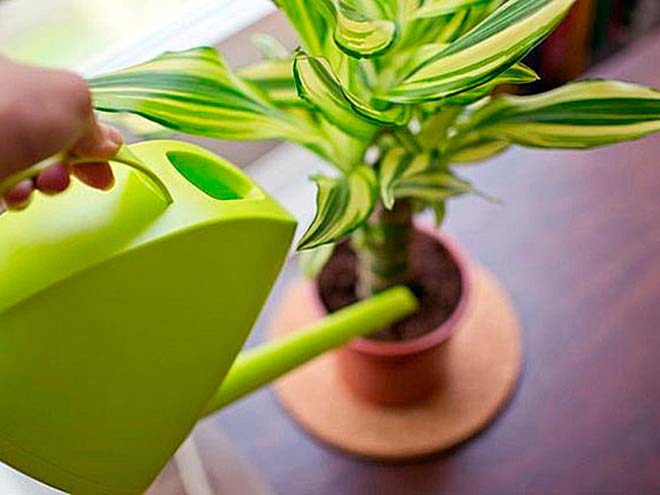
You can determine that a flower needs watering by the degree of soil moisture. If the earthen lump has dried 3 cm from the surface, the soil must be moistened. This can be done in three ways:
Regular overhead watering. Water must be poured into the soil around the root.
In the pallet. A special mixture or ordinary pebbles are poured over with water and placed in a flat wide tray. Then a pot of dracaena is installed there.
It is important that there are holes at the bottom of the pot through which the root system of the flower will draw water.
Bathing. 1-2 times a week, you can transfer the pot with the plant to the bathtub and completely "bathe" it under the shower
After that, you need to wait until all excess moisture is drained off so that there is no stagnation of water.
Excessive watering can lead to rotting of the trunk first, and then the leaves of the bush. After watering, loosening should be performed to increase air access to the roots.
Fertilization is carried out in the spring before the start active growth. You need to apply top dressing once a month. Use ready-made complex fertilizers in the form of a liquid mixture, which are preliminarily diluted with water for irrigation.
Fertilizers should not be poured into unmoistened soil, otherwise burns may remain on the root system.
Care and reproduction of fragrant dracaena (fragrance) in the photo
The plant is quite unpretentious, however, for successful cultivation, it requires compliance with certain rules of care. Dracaena fragrance differs in greater tolerance to lack of lighting than other species. Varieties with dark green monochromatic leaves grow well in the shade, but variegated forms in such conditions lose their brightness. Optimal for a flower is bright diffused light without direct sunlight, location near east or even south windows, covered with a thin curtain. With an excess of sun, the leaves turn yellow, the variegated color turns pale.
In the summer, this species can be taken out into the open air, protecting it from drafts and direct sunlight. The temperature favorable for growth and development is from 19 to 25 ° С; in winter, the flower can withstand its decrease to + 10 ° С.
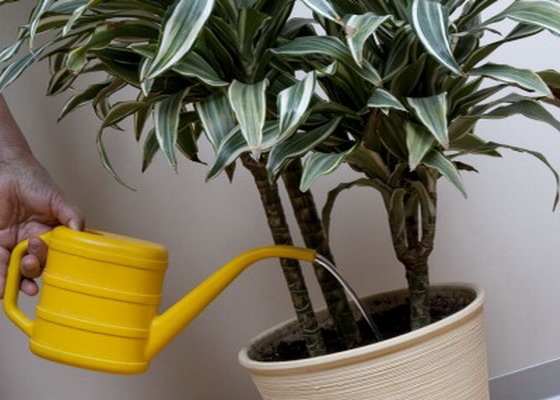
Dracaena care in the photo
The culture is demanding on air humidity, requires daily spraying with water at room temperature, which will prevent yellowing of the tips of the leaves. If it is impossible to spray, the plants are placed on a tray with damp pebbles, where water is regularly added. To maintain decorativeness, damaged ends can be trimmed.
To remove dust, it is necessary to wipe the plant with a damp sponge throughout the year; for the same purpose, a warm shower is arranged for it. All dracaena do not tolerate leaf polishing agents well; in representatives of this species, it is possible to polish them occasionally, no more than once every 2 months, using folk remedies (for example, alcohol, diluted citric acid, glycerin). You cannot polish young, growing leaves, expose the flower in the sun after the procedure to avoid burns.
Watering should be regular, the culture needs to maintain constant moisture in the earthen coma, while it does not tolerate overflow and stagnation of water. It is usually sufficient to water the plant 2 times a week in the summer and once every 10-12 days in the winter. Overdrying the substrate is also unacceptable, if a high temperature is maintained in the room in winter, it is better to increase the frequency of watering. It is useful to loosen the top layer of the substrate once a month, which has a beneficial effect on the root system, increasing air access to it.
The flower is fed throughout the year, using complex flower or special fertilizers for dracaena and palms, twice a month in summer, monthly in winter, with a half dose. There should be a minimum amount of phosphorus in top dressing, since this element is usually accompanied by fluorine, which the plant does not tolerate.
The transplant is carried out no more than once every 2 years for young specimens, at 3-4 years for older ones. For large trees, it is sufficient to replace the topsoil. To protect the root system from damage, transshipment is used. The plant must be provided with good drainage, a special soil for palms and dracaena, to which you can add some of the sand, as well as pieces of coal and brick chips.
Pruning is done to limit growth and crown formation. The top is cut so that 4-5 leaves remain on the trunk. To stimulate the formation of lateral shoots, the cut site can be closed with polyethylene. After a month, young shoots usually appear, as they grow, the package is removed.
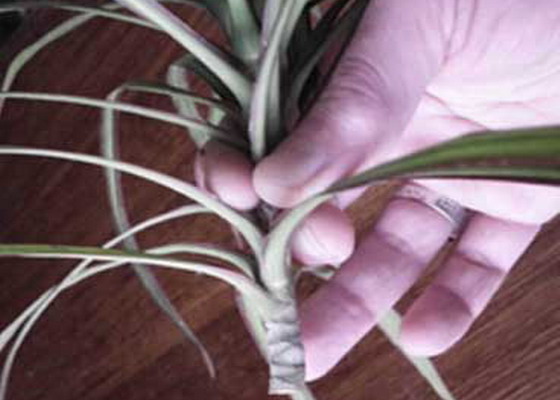
Reproduction of dracaena in the photo
For the propagation of fragrant dracaena, apical cuttings 10-15 cm long or stem segments 5-7 cm long are used. Rooting can be done in a container with water, where activated carbon is added to prevent decay processes, or in a wet substrate. The best time for this is spring or late summer.
With the creation of suitable conditions and good care, the fragrant dracaena is practically not damaged by pests and diseases, it retains its decorative appearance for a long time and can serve as a decoration for any interior.
Fragrant dracaena: how to properly care
Fragrant dracaena is a large evergreen plant native to the African continent. In nature, it grows up to 6 m in height, at home - no more than 2 m. It has a strong trunk and beautiful long leaves with a glossy sheen, densely growing on the stem. Their color is monotonous green and combining several shades, for example, green with white or light green.
Home care
Features of care after purchase
Dracaena is a plant from the tropics and does not like low temperatures very much. If the purchase is made in the cold season, at a street temperature of up to +10 degrees, it is necessary to take care of the insulation in advance for the time of its transfer from the store to the apartment.
It is best to pack the flower in several layers of paperand then place in a tight-fitting bag or bag. In cold weather, it is best to use a special thermal bag. When frostbite leaves dracaena lime become covered with black spots and die off.
Upon arrival home, you need to give time to get used to the new place. Moving to a new pot can be done two weeks after the purchase.
Lighting
Dracaena Lemon Lime loves bright light, which is necessary for quality growth and development. Therefore, it is best for the plant to choose a well-lit place, but at the same time with diffused light. It is necessary to avoid direct sunlight, which is detrimental to its leaves.
If the dracaena is only in the shade, then the leaves may begin to lose their color, and the bright stripes will fade over time. In order for the crown not to start stretching towards the light source, the flower pot must be periodically turned.
In winter, when the sun shines a little, dracaena can be transferred to the southern windows, or artificial lighting can be used. A small amount of light leads to poor growth and disease.
Temperature
Dracaena is thermophilic, so the temperature in the room should not drop below +15 degrees.
In the spring and summer months, it is recommended to maintain the temperature at + 25-27 degrees. Higher values can negatively affect the crown of the plant.
But in autumn and winter, the optimal temperature is + 16-18 degrees. Frosts are destructive for her.
Air humidity
The plant loves humid air, but can tolerate the dryness of modern apartments relatively painlessly. During the summer, the leaves can be sprayed with water, the temperature of which is 2-3 degrees higher than that of the air. About once every 2 weeks, you need to wipe them with a damp cloth from dust and dirt, or wash them in the bath under the shower.
Watering
During spring and summer, dracaena must be watered abundantly 1-2 times a week, but at the same time periodically arrange for drying - the earthen lump should dry well, since constantly moist earth quickly leads to root rot. Excess water from the sump is drained.
In winter, watering is significantly reduced - no more than 1 time per week, and is carried out as the earth dries up. Watering is always done with settled water at room temperature.
Fertilizers (top dressing)
The plant is fed with a complex fertilizer, in the summer - once a week, in the winter - once a month.
In no case should you apply top dressing during the period of plant illness!
Transfer
Always performed after purchasing dracaena in the store.There are no serious reasons for a complete change of land - usually it can be transplanted entirely into a more spacious container, then adding fresh substrate.
But here it is necessary to bear in mind the following point - when delivered from abroad, some dracaena are brought in special soil intended only for transportation. You can clarify this point with the store's consultants. In this case, the plant must be moved with a complete replacement of the soil.
The old dracaena should be replanted when the roots completely fill the previous pot. This usually happens every 2-3 years.
Optimally, the new container for the flower should be at least 2.5-3 cm larger than the current one. The best time for such an operation is March. Be sure to create good drainage.
Growing
Growing dracaena from seeds can only be done for some green-leaved species. Due to the lack of flowering in the apartment, it is quite difficult to obtain dracaena seeds.
Reproduction
For reproduction of Dracaena Lime, stem or apical cuttings, 30-35 centimeters in size, are used. In the latter case, this is the cut off top bunch of leaves together with a part of the plant trunk. For rooting, the cuttings are placed in a jar with water and coarse sand at the bottom (5 centimeters layer).
After the formation of roots, they are planted in specially prepared soil, which consists of peat and sand in a ratio of 50 to 50%. During this period, you can actively use phytohormones - growth stimulants.
We take care of dracaena correctly
The plant is unpretentious. But, as in caring for any indoor plants, individual rules are required.
Dracaena fragrance
differs in endurance in comparison with other relatives and perfectly tolerates a lack of light. Subspecies with solid dark green leaves show excellent growth rates in the shade, but variegated forms quickly lose their bright color. The best is considered to be bright, evenly diffused light from windows on the south or east side.

Important! From frequent contact with unscattered sunlight, the leaves of the dracaena turn yellow, and the color becomes paler. Remember to remove dust from the plant
Do this periodically throughout the year: wipe the leaves with a damp sponge, sometimes give the dragon a warm shower. It is not recommended to use leaf polish products, since plants of this species do not react well to chemistry. Instead of purchased products, you can use folk remedies: alcohol, diluted citric acid, glycerin, but process the plant no more than 1-2 times a month
Remember to remove dust from the plant. Do this periodically throughout the year: wipe the leaves with a damp sponge, sometimes give the dragon a warm shower. It is not recommended to use leaf polish products, since plants of this species do not react well to chemistry. Instead of purchased products, you can use folk remedies: alcohol, diluted citric acid, glycerin, but process the plant no more than 1-2 times a month.
How to care?
Dracaena fragrant does not pose any danger to humans during cultivation at home. The plant is not poisonous, does not emit dangerous and toxic substances.
As a rule, the basic rules for caring for a plant are quite simple, lovers of indoor flowers note the unpretentiousness of dracaena in terms of the conditions created. However, there are certain points that should be provided to the culture for productive development and flowering.
Lighting
Home care primarily involves choosing an appropriate place for the growth of dracaena. This culture belongs to light-loving indoor plants, but the incoming sunlight should not be direct, as this can cause a burn of the green mass. It is best to place the dracaena pot in places with diffused light, for example, on windowsills from the southeast or southwest side.
Temperature
The most suitable air temperature for fragrant dracaena will be the range from + 18 ° C to + 25 ° C in the spring-summer period. As for the winter months, the optimal indicator for crops will be cool air, but not lower than + 15 ° C.
Humidity
The flower needs regular moisture, without daily spraying, dracaena leaves often turn yellow, especially on hot summer days. This is also due to the peculiarity of the culture, which is actively developing at this time, which means it evaporates moisture. In addition to spraying, it would be more correct to regularly wipe the green mass of dracaena with a damp cloth so that the flower retains good air exchange.
Watering
As for the direct introduction of moisture through the soil, the indoor culture does not require frequent and abundant watering, since it is a drought-resistant plant. In the growth phase, which occurs in spring and summer, 2 waterings per week will be enough for dracaena. With the onset of a dormant period, it is worth switching to one-time watering.
Top dressing
Exot responds positively to the introduction of fertilizers, so the owners of fragrant dracaena should provide the plant with additional feeding every month. For these purposes, a special store-bought vitaminized complex is used, intended for palms and ornamental home crops. In winter, the flower does not need fertilization.
About caring for Dracaena Fragrant, Deremskaya or Fragrans:
Temperature: The optimum temperature for Dracena in summer is 19-25 ºC, while in winter the temperature should not drop below 10 ºC. In summer, you need to monitor the temperature, if the weather is hotter, you need to increase watering and spraying. It should not be forgotten that in winter it must be protected from cold drafts. Also, when the central heating is working, Dracaena must be sprayed twice a day, and the leaves must be wiped with a damp sponge.

Lighting: Fragrant Dracaena prefers bright lighting, without direct sunlight. An ideal place for it would be a west or east window, but if your windows face the south side, you need to create diffused lighting for it. This type of Dracen loves fresh air, so in summer it can be taken out onto a balcony or terrace, but back, make sure that no direct sunlight falls on it.
Watering: Dracaena Deremsis must be watered abundantly and regularly. In the summer, twice a week, if necessary, watering is increased, you should be guided by the drying out of the earthen coma. If the topsoil is 2-3 cm deep, it is necessary to water it. In winter, during the dormant period, watering is reduced to once a week, but if the plant is near a heating device, you will have to water it more often. Water must be used separated or filtered. Dracaena Fragransa normally tolerates dry air, but from time to time she still does not refuse to spray, especially in summer and winter if she stands next to a heating device. Try not to overmoisten the roots of the plant. It is highly recommended to loosen the topsoil once a month for better air flow to the roots.
 Dracaena fragrans Lemon Lime.
Dracaena fragrans Lemon Lime.
Fertilizer: Fertilizing Dracena Fragrans is necessary during the period of active growth, from March to September. Fertilize the plant twice a month.
Soil: Soil for palm trees is suitable for Dracaena, you can also use a mixture of leaf, compost and turf soil with the addition of sand, peat. Good drainage is essential. It is recommended to add pieces of charcoal to the substrate, which will serve as the prevention of root diseases, you can also add a little brick chips to increase the looseness of the soil.

Transplant: It is necessary to transplant Dracena Fragrant, Deremsis or Fragrans after purchase in two weeks. Young Dracena plants are transplanted once every 2 years as the plants grow. Adult plants are transplanted once every 3 years. In order to determine whether it is necessary to transplant dracaena, it is necessary to compare plant height diameter a pot, for example, for a plant with a height of 40 centimeters, a pot with a diameter of 15 centimeters is required. You can transplant at any time of the year, but if possible, it is better to wait for spring. Transplanting must be done carefully, using the transshipment method, in order to avoid damage to the roots. In adult plants that grow in tubs, it is necessary to change the topsoil annually.
Reproduction: You can read about the reproduction of Dracaena in this article: Dracaena: description, types, pruning, reproduction.
Pests of Dracaena Fragrant. May be affected by spider mites, aphids, mealybugs, scale insects, thrips. For prevention, you need to use a warm shower, wipe the leaves.

How to prune a dracaena for branching
Dracaena must be pruned regularly, this stimulates branching, promotes plant renewal. Pruning will make the dracaena lush and beautiful, the branched plant looks more interesting and there is no bare trunk. Nuances of the procedure:
- The best time is spring or summer.
- An adult dracaena with a height of at least 30 cm should be pruned.
- Pruning is carried out in the place where you want to branch, under the lower leaves by 5-7 cm.
- Cut with a sharp knife at an angle.
- The place of the cut stems is sprinkled with activated carbon powder, then treated with Zircon or filled with molten paraffin.
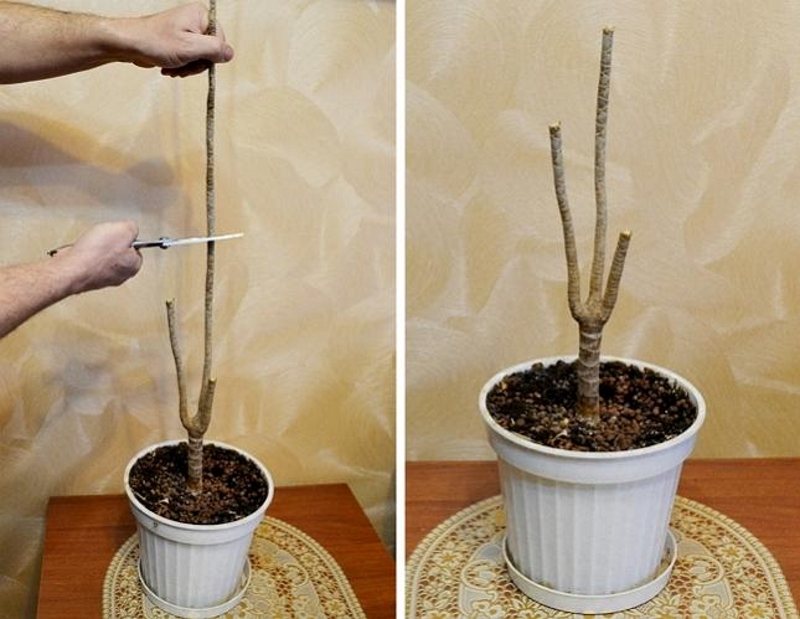
Dracaena pruning is done to increase branching
After the procedure, you need to put the dracaena in a darkened place and spray it more often, and close the cut place with a small piece of wet moss and film on top. The kidneys will appear in 1-1.5 months, then the film can be removed.
Cut off shoots can be placed in water, wait for their rooting and transplanted to the main plant. Over time, an interesting multilevel composition is formed in the pot.
What varieties of Dracaena bloom
Not all dracaena are capable of producing flowers. Barren plants are considered safe and optimal for living and public areas. However, there are several varieties that produce lush, pleasing-looking flowers. As a rule, they look like conical candles or panicles, where many small flowers are collected in a common bouquet. The shade of dracaena flowers ranges from white and pale cream to pinkish brown nodules.

Contrasting red buds look beautiful against the background of delicate variegated foliage
Another important feature is the pronounced aroma of the buds. Important! Many varieties of trees are toxic, it is dangerous to inhale vapors of its juice with pollen.
Important! Many varieties of trees are toxic, it is dangerous to inhale the vapors of its sap with pollen. This can cause not only allergies and dizziness, but also poisoning.
Some varieties give off a pungent, unpleasant odor similar to fresh organic debris and sugary pollen. Others have a pleasant floral bouquet that combines notes of fruit, ether and herbaceous undertones.
This can cause not only allergies and dizziness, but also poisoning. Some varieties give off a pungent, unpleasant odor similar to fresh organic debris and sugary pollen. Others have a pleasant floral bouquet that combines notes of fruit, ether and herbaceous nuances.
There are more than 100 varieties in the genus Dracaena, among which only 4 types can bloom in an unusual environment, for example, in the middle latitudes of Russia:
- Dracaena Godseffiana is a short bush with rather wide and spreading oval leaves that include creamy blotches. This subspecies dissolves yellowish flowers with a pleasant flair.
- Dracaena Fragrans is a fragrant variety that blooms most often indoors. The tree grows up to 2 m, which is remarkable - after flowering it branches. This is a frost-resistant type that is not afraid of temperatures down to –10 ° С.
- Dracaena Marginata or Bordered is an interesting species with a ringed trunk and thin leaves, highlighted by purple edging. The Marginata plant has faded, unpleasant-smelling flowers, so flowering should be avoided.
- The Dracaena Deremensis, or Derem variety, is another dangerous pungent type that produces red buds. Flowering is very rare. The exception for this species is the Varneschi palm, which produces fluffy white panicles with a pleasant aroma.
On a note! Dracaena opens its flowers and releases a bright aroma only at night, during the day the flowers close in tight knots. This prevents aggressive insects from harming the plant.

